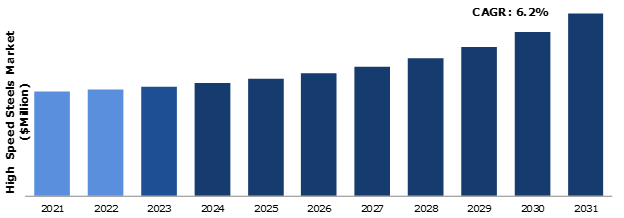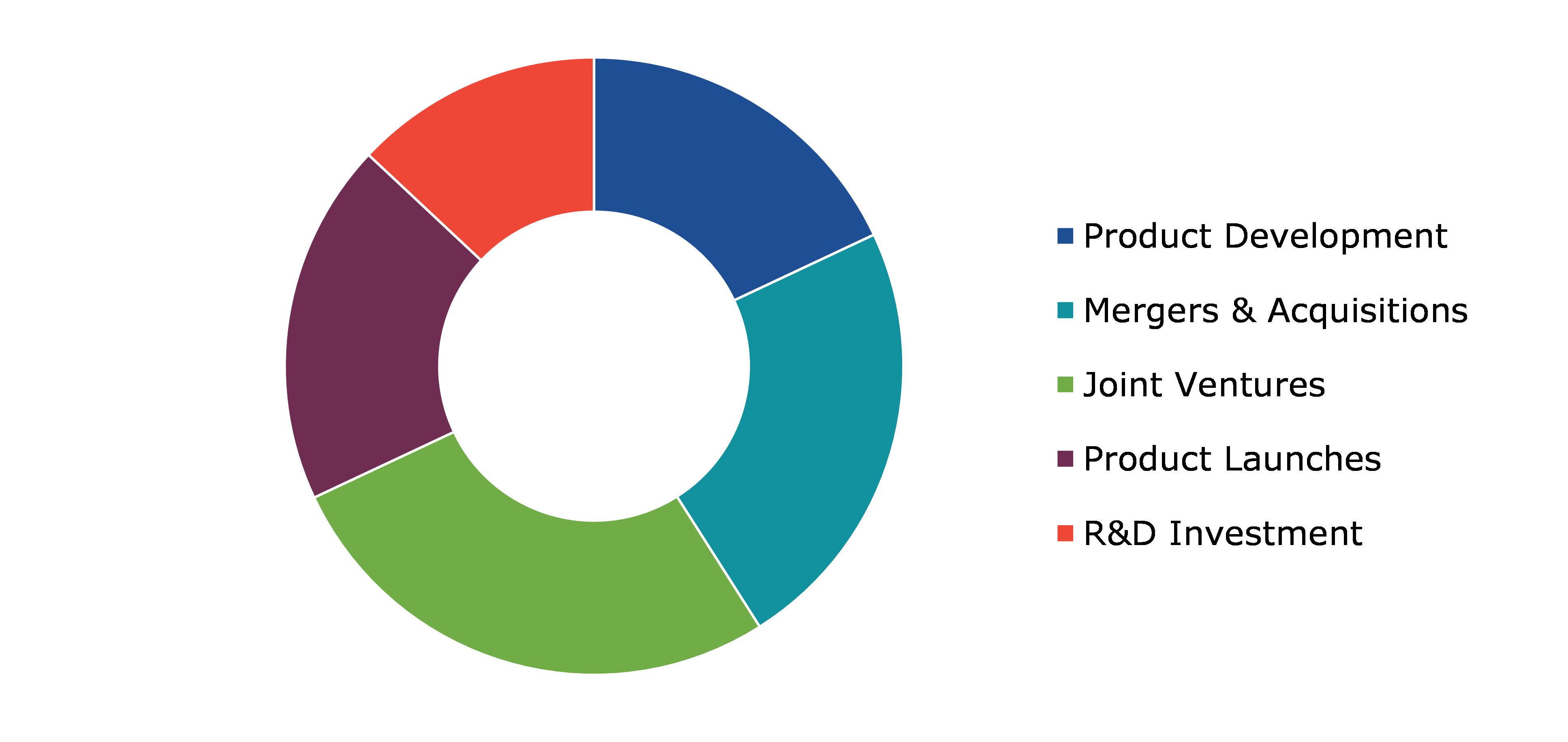High Speed Steels Market Report
RA07721
High Speed Steels Market by Type (Tungsten High Speed Steel, Molybdenum High Speed Steel, Cobalt High Speed Steel, and Others), Production Method (Conventional HSS, Powder Metallurgy (PM) HSS, and Spray Forming (SF) HSS), Grade (M Grade, T Grade, and Advance Grade), End User (Automotive, Manufacturing, Aerospace, Mechanical Engineering, Construction, and Others), and Region (North America, Europe, Asia-Pacific, and LAMEA): Opportunity Analysis and Industry Forecast, 2023-2032
High Speed Steels Overview
High-speed steel (HSS) is an extremely hard and durable alloy with several applications in engineering, manufacturing, building, and other fields. It is made to endure high temperatures and has a high wear resistance. High-speed steel is an iron alloy with tungsten, molybdenum, chromium, vanadium, carbon, cobalt, manganese, nickel, silicon, titanium, and niobium (also known as columbium). It is one of the most popular materials used in the manufacturing of cutting tools owing to its mix of hardness and longevity. This factor makes it perfect for cutting and drilling operations.
High-speed steel can be used in a variety of applications, including machining operations such as boring or drilling metal pieces, sawing through tough materials such as stainless steel, precision cutting of intricate shapes, milling difficult materials such as hardened steel, producing strong thread forms on metal components, grinding hard surfaces, making smooth finishes on metal surfaces, punching holes through metal sheets, and sharpening blades quickly without wearing dowels.
Global High Speed Steels Market Analysis
The global high speed steels market size was $5,342.90 million in 2022 and is predicted to grow with a CAGR of 6.2%, by generating a revenue of $9,387.00 million by 2032.
Source: Research Dive Analysis
COVID-19 Impact on Global High Speed Steels Market
The high speed steels market has been impacted significantly owing to the COVID-19 outbreak. The market has faced a number of challenges due to supply chain disruptions, lower demand, and economic insecurity. Furthermore, cutting tool demand was declined as a result of the pandemic's impact on the shutdown of various industries. The pandemic had a severe impact on the entire industrial sector, which is a major user of cutting tools. Since many manufacturers reduced their output, the need for high-speed steel cutting tools has significantly fallen. Cutting tool production was also hampered by raw material and component shortages caused by the supply chain disruption.
Despite these challenges, the high-speed steels sector has shown remarkable resilience and adaptation. Many companies are now focusing on developing cutting-edge solutions for critical industries such as healthcare and food manufacturing. The need for high-speed steels is expected to rise as production becomes more automated and digitalized.
Increasing Investment in Industrial Machinery and Machining Equipment is a Major Factor Driving Market Growth
Increasing investment in industrial machinery and machining equipment is a major factor driving the growth of the high speed steels market. High-speed steels (HSS) are a type of tool steel specifically designed for applications that require high cutting speeds, heat resistance, and durability. CNC machines and advanced cutting tools, for example, are critical pieces of industrial machinery and machining equipment for modern manufacturing processes. To achieve efficient and precise machining operations, these machines require high-performance cutting tools. High-speed steels are commonly used as cutting tool materials because of their ability to endure high temperatures and keep sharpness even at high cutting speeds. Growing industrialization and manufacturing operations in many sectors generally promote increased investment in industrial machinery and machining equipment. The need for high-speed steels for cutting tools increases as industries expand and strive to improve productivity. All these factors are anticipated to boost the high speed steels market growth in the upcoming years.
To know more about global high speed steels market drivers, get in touch with our analysts here.
Availability of Alternatives to Hamper Market Growth
Easy availability of alternatives such carbide tools is projected to hamper the high speed steels market revenue growth during the forecast period. Carbide tools and its applications continue to be a key competitor and a viable alternative to high-speed steel tools. Carbide steel tools are 6-7 times faster than steel tools and have superior hardness and wear resistance, which makes them more preferable over HSS tools. Cemented carbide is a very hard substance that is utilized as a cutting tool in a variety of industrial applications. Carbide drills are comparatively strong and durable, making them ideal for high-volume whole-production with a high material removal rate. All these factors are anticipated to hinder the market expansion in the future.
Usage of HSS Across Variety Of Industries to Drive Excellent Opportunities
HSS is used in a variety of industries, including machine tools, dies and molds, aerospace, automotive, and mechanical engineering. HSS is used to create gears by way of shaper cutters, milling cutters, broaches, hobs, shaver cutters, and bevel cutters because of its adaptability. Molybdenum and tungsten balancing has undergone modifications as a result of later R&D. For HSS market player, attributes like wear resistance, hardness, and temperature resistance, among others, open up a wide range of applications. Vanadium and cobalt are two additional elements that are added to HSS in order to improve its further qualities. Future developments in HSS production methods will provide the material more demand in the market for a range of unexplored uses.
To know more about global high speed steels market opportunities, get in touch with our analysts here.
Global High Speed Steels Market Share, by Type, 2022
Source: Research Dive Analysis
The molybdenum high speed steel sub-segment accounted for the highest high speed steels market share in 2022. Molybdenum is a silvery white metal that can be combined with other elements to form alloys. It is a strong carbide former that increases temper brittleness and fine grain formation. Molybdenum has a strong weldability and secondary hardening propensity during tempering. Molybdenum steels have a lower melting point than tungsten steels. Molybdenum may form a double carbide with iron and carbon, allowing it to be substituted for tungsten at a ratio of one component molybdenum to two parts tungsten. Molybdenum high-speed steels are also known as Group M steels. These steels account for more than 95% of all high-speed steels produced in the U.S. Although both types of high-speed steels operate equally well, Group M steels have a cheaper initial cost. Tools produced of high-speed tool steel can be coated with titanium carbide, titanium nitride, and other coatings utilizing a physical vapor deposition method for improved performance and tool life.
Global High Speed Steels Market Share, by Production Method, 2022
Source: Research Dive Analysis
The powder metallurgy (PM) HSS sub-segment accounted for the highest high speed steels market share in 2022. Powder metallurgy (PM) is a manufacturing process that involves the production of metal parts using powdered metal as the starting material. When it comes to high-speed steel (HSS) for high-speed tool applications, powder metallurgy offers several advantages such as improved tool performance. PM HSS can be formulated with precise control over its chemical composition and microstructure. This allows for the optimization of tool performance characteristics such as hardness, wear resistance, toughness, and hot hardness. PM HSS can be customized to meet specific requirements for different cutting applications, resulting in improved tool performance and longer tool life.
Global High Speed Steels Market Share, by Grade, 2022
Source: Research Dive Analysis
The M grade sub-segment accounted for the highest market share in 2022. High-speed steel (HSS) is a type of tool steel known for its exceptional toughness, hardness, and heat resistance. The M-grade designation refers to a specific type of high-speed steel composition. M-grade high-speed steel exhibits high hardness, typically in the range of 62-67 HRC (Rockwell hardness). This hardness enables it to withstand high temperatures without losing its cutting ability or durability. HSS with M-grade composition has excellent hot hardness, which means it retains its hardness even at high temperatures. This characteristic is crucial for tools that operate at high speeds and generate significant heat during cutting or machining processes.
Global High Speed Steels Market Share, by End User, 2022
Source: Research Dive Analysis
The automotive sub-segment accounted for the highest market share in 2022. High speed steels cutting tools are used in the engine, gearbox, and body panel output.
Mechanical properties and ranges, thickness and width capabilities, hot-rolled, cold-rolled, and coating availability, and chemical composition specifications all contribute to high-speed steel's increased demand in the automobile industry. Steel's strength is usually defined by its microstructure in the automotive sector, which varies depending on its chemical composition, history with heat, and the deformation operations it goes through during its production process. High-speed steel has many advantages over conventional steel, particularly in the automotive industry, where weight is an important element in how efficiently fuel is used. Their mechanical qualities, such as weldability, fatigue resistance, static strength, cathodic protection, and resistance to hydrogen embrittlement, are assisting the automotive sector.
Global High Speed Steels Market Size & Forecast, by Region, 2022-2032 ($Million)
Source: Research Dive Analysis
The North America high speed steels market generated the highest revenue in 2022. There is an increase in use of cutting tools in numerous industries such as automotive, aerospace, and others in North America. One of the primary drivers supporting the regional market expansion is the developed industrial sector of the U.S. According to CMS' Office of the Actuary estimates, the manufacturing industry accounts for 10.8% of the U.S. economy in terms of Gross Domestic Product (GDP). Furthermore, the U.S. remains one of the world's major markets for industrial equipment, making it a profitable market for manufacturers of HSS tools. Furthermore, important end-use sectors such as automotive & transportation, oil & gas, and construction, are likely to boost the demand across the region.
Competitive Scenario in the Global High Speed Steels Market
Investment and agreement are common strategies followed by major market players. In June 2021, Desktop Metal unveiled 4140 low-alloy steels for applications in production system platforms with the company’s proprietary single pass jetting technology for mass production applications. In addition, Tiangong International Company Limited announced the acquisition of Quintus Technologies with the goal of increasing manufacturing capacity by expanding its Jiangsu production the facility.
Source: Research Dive Analysis
Some of the leading high speed steel market players are Sandvik AB, NIPPON KOSHUHA, TEEL CO., LTD., Proterial, Ltd., ArcelorMittal, Amada Co., Ltd, OSG corporation, Kennametal, Kyocera, Walter AG, and RUKO GmbH.
| Aspect | Particulars |
| Historical Market Estimations | 2020-2021 |
| Base Year for Market Estimation | 2022 |
| Forecast Timeline for Market Projection | 2023-2032 |
| Geographical Scope | North America, Europe, Asia-Pacific, and LAMEA |
| Segmentation by Type |
|
| Segmentation by Production Method |
|
|
Segmentation by Grade
|
|
| Segmentation by End User
|
|
| Key Companies Profiled |
|
Q1. What is the size of the global high speed steels market?
A. The size of the global high speed steels market was over $5,342.90 million in 2022 and is projected to reach $9,387.00 million by 2032
Q2. Which are the major companies in the high speed steels market?
A. Sandvik AB, NIPPON KOSHUHA STEEL CO., LTD., and Proterial, Ltd. are some of the key players in the global high speed steels market.
Q3. Which region, among others, possesses greater investment opportunities in the future?
A. Asia-Pacific possesses great investment opportunities for investors in the future.
Q4. What will be the growth rate of the Asia-Pacific high speed steels market?
A. Asia-Pacific high speed steels market is anticipated to grow at 5.6% CAGR during the forecast period.
Q5. What are the strategies opted by the leading players in this market?
A. : Agreement and investment are the two key strategies opted by the operating companies in this market.
Q6. Which companies are investing more on R&D practices?
A. OSG corporation, Kennametal, and Kyocera are the companies investing more on R&D activities for developing new products and technologies.
1.Research Methodology
1.1.Desk Research
1.2.Real time insights and validation
1.3.Forecast model
1.4.Assumptions and forecast parameters
1.5.Market size estimation
1.5.1.Top-down approach
1.5.2.Bottom-up approach
2.Report Scope
2.1.Market definition
2.2.Key objectives of the study
2.3.Report overview
2.4.Market segmentation
2.5.Overview of the impact of COVID-19 on Global High Speed Steels Market
3.Executive Summary
4.Market Overview
4.1.Introduction
4.2.Growth impact forces
4.2.1.Drivers
4.2.2.Restraints
4.2.3.Opportunities
4.3.Market value chain analysis
4.3.1.List of raw material suppliers
4.3.2.List of manufacturers
4.3.3.List of distributors
4.4.Innovation & sustainability matrices
4.4.1.Technology matrix
4.4.2.Regulatory matrix
4.5.Porter’s five forces analysis
4.5.1.Bargaining power of suppliers
4.5.2.Bargaining power of consumers
4.5.3.Threat of substitutes
4.5.4.Threat of new entrants
4.5.5.Competitive rivalry intensity
4.6.PESTLE analysis
4.6.1.Political
4.6.2.Economical
4.6.3.Social
4.6.4.Technological
4.6.5.Environmental
4.7.Impact of COVID-19 on High Speed Steels Market
4.7.1.Pre-covid market scenario
4.7.2.Post-covid market scenario
5.High Speed Steels Market Analysis, by Type
5.1.Overview
5.2.Tungsten High Speed Steel
5.2.1.Definition, key trends, growth factors, and opportunities
5.2.2.Market size analysis, by region, 2022-2032
5.2.3.Market share analysis, by country, 2022-2032
5.3.Molybdenum High Speed Steel
5.3.1.Definition, key trends, growth factors, and opportunities
5.3.2.Market size analysis, by region, 2022-2032
5.3.3.Market share analysis, by country, 2022-2032
5.4.Cobalt High Speed Steel
5.4.1.Definition, key trends, growth factors, and opportunities
5.4.2.Market size analysis, by region, 2022-2032
5.4.3.Market share analysis, by country, 2022-2032
5.5.Others
5.5.1.Definition, key trends, growth factors, and opportunities
5.5.2.Market size analysis, by region, 2022-2032
5.5.3.Market share analysis, by country, 2022-2032
5.6.Research Dive Exclusive Insights
5.6.1.Market attractiveness
5.6.2.Competition heatmap
6.High Speed Steels Market Analysis, by Production Method
6.1.Conventional HSS
6.1.1.Definition, key trends, growth factors, and opportunities
6.1.2.Market size analysis, by region, 2022-2032
6.1.3.Market share analysis, by country, 2022-2032
6.2.Powder Metallurgy (PM) HSS
6.2.1.Definition, key trends, growth factors, and opportunities
6.2.2.Market size analysis, by region, 2022-2032
6.2.3.Market share analysis, by country, 2022-2032
6.3.Spray Forming (SF) HSS
6.3.1.Definition, key trends, growth factors, and opportunities
6.3.2.Market size analysis, by region, 2022-2032
6.3.3.Market share analysis, by country, 2022-2032
6.4.Research Dive Exclusive Insights
6.4.1.Market attractiveness
6.4.2.Competition heatmap
7.High Speed Steels Market Analysis, by Grade
7.1.M Grade
7.1.1.Definition, key trends, growth factors, and opportunities
7.1.2.Market size analysis, by region, 2022-2032
7.1.3.Market share analysis, by country, 2022-2032
7.2.T Grade
7.2.1.Definition, key trends, growth factors, and opportunities
7.2.2.Market size analysis, by region, 2022-2032
7.2.3.Market share analysis, by country, 2022-2032
7.3.Advance Grade
7.3.1.Definition, key trends, growth factors, and opportunities
7.3.2.Market size analysis, by region, 2022-2032
7.3.3.Market share analysis, by country, 2022-2032
7.4.Research Dive Exclusive Insights
7.4.1.Market attractiveness
7.4.2.Competition heatmap
8.High Speed Steels Market Analysis, by End User
8.1.Automotive
8.1.1.Definition, key trends, growth factors, and opportunities
8.1.2.Market size analysis, by region, 2022-2032
8.1.3.Market share analysis, by country, 2022-2032
8.2.Manufacturing
8.2.1.Definition, key trends, growth factors, and opportunities
8.2.2.Market size analysis, by region, 2022-2032
8.2.3.Market share analysis, by country, 2022-2032
8.3.Aerospace
8.3.1.Definition, key trends, growth factors, and opportunities
8.3.2.Market size analysis, by region, 2022-2032
8.3.3.Market share analysis, by country, 2022-2032
8.4.Mechanical Engineering
8.4.1.Definition, key trends, growth factors, and opportunities
8.4.2.Market size analysis, by region, 2022-2032
8.4.3.Market share analysis, by country, 2022-2032
8.5.Construction
8.5.1.Definition, key trends, growth factors, and opportunities
8.5.2.Market size analysis, by region, 2022-2032
8.5.3.Market share analysis, by country, 2022-2032
8.6.Others
8.6.1.Definition, key trends, growth factors, and opportunities
8.6.2.Market size analysis, by region, 2022-2032
8.6.3.Market share analysis, by country, 2022-2032
8.7.Research Dive Exclusive Insights
8.7.1.Market attractiveness
8.7.2.Competition heatmap
9.High Speed Steels Market, by Region
9.1.North America
9.1.1.U.S.
9.1.1.1.Market size analysis, by Type, 2022-2032
9.1.1.2.Market size analysis, by Production Method, 2022-2032
9.1.1.3.Market size analysis, by Grade, 2022-2032
9.1.1.4.Market size analysis, by End User, 2022-2032
9.1.2.Canada
9.1.2.1.Market size analysis, by Type, 2022-2032
9.1.2.2.Market size analysis, by Production Method, 2022-2032
9.1.2.3.Market size analysis, by Grade, 2022-2032
9.1.2.4.Market size analysis, by End User, 2022-2032
9.1.3.Mexico
9.1.3.1.Market size analysis, by Type, 2022-2032
9.1.3.2.Market size analysis, by Production Method, 2022-2032
9.1.3.3.Market size analysis, by Grade, 2022-2032
9.1.3.4.Market size analysis, by End User, 2022-2032
9.1.4.Research Dive Exclusive Insights
9.1.4.1.Market attractiveness
9.1.4.2.Competition heatmap
9.2.Europe
9.2.1.Germany
9.2.1.1.Market size analysis, by Type, 2022-2032
9.2.1.2.Market size analysis, by Production Method, 2022-2032
9.2.1.3.Market size analysis, by Grade, 2022-2032
9.2.1.4.Market size analysis, by End User, 2022-2032
9.2.2.UK
9.2.2.1.Market size analysis, by Type, 2022-2032
9.2.2.2.Market size analysis, by Production Method, 2022-2032
9.2.2.3.Market size analysis, by Grade, 2022-2032
9.2.2.4.Market size analysis, by End User, 2022-2032
9.2.3.France
9.2.3.1.Market size analysis, by Type, 2022-2032
9.2.3.2.Market size analysis, by Production Method, 2022-2032
9.2.3.3.Market size analysis, by Grade, 2022-2032
9.2.3.4.Market size analysis, by End User, 2022-2032
9.2.4.Spain
9.2.4.1.Market size analysis, by Type, 2022-2032
9.2.4.2.Market size analysis, by Production Method, 2022-2032
9.2.4.3.Market size analysis, by Grade, 2022-2032
9.2.4.4.Market size analysis, by End User, 2022-2032
9.2.5.Italy
9.2.5.1.Market size analysis, by Type, 2022-2032
9.2.5.2.Market size analysis, by Production Method, 2022-2032
9.2.5.3.Market size analysis, by Grade, 2022-2032
9.2.5.4.Market size analysis, by End User, 2022-2032
9.2.6.Rest of Europe
9.2.6.1.Market size analysis, by Type, 2022-2032
9.2.6.2.Market size analysis, by Production Method, 2022-2032
9.2.6.3.Market size analysis, by Grade, 2022-2032
9.2.6.4.Market size analysis, by End User, 2022-2032
9.2.7.Research Dive Exclusive Insights
9.2.7.1.Market attractiveness
9.2.7.2.Competition heatmap
9.3.Asia-Pacific
9.3.1.China
9.3.1.1.Market size analysis, by Type, 2022-2032
9.3.1.2.Market size analysis, by Production Method, 2022-2032
9.3.1.3.Market size analysis, by Grade, 2022-2032
9.3.1.4.Market size analysis, by End User, 2022-2032
9.3.2.Japan
9.3.2.1.Market size analysis, by Type, 2022-2032
9.3.2.2.Market size analysis, by Production Method, 2022-2032
9.3.2.3.Market size analysis, by Grade, 2022-2032
9.3.2.4.Market size analysis, by End User, 2022-2032
9.3.3.India
9.3.3.1.Market size analysis, by Type, 2022-2032
9.3.3.2.Market size analysis, by Production Method, 2022-2032
9.3.3.3.Market size analysis, by Grade, 2022-2032
9.3.3.4.Market size analysis, by End User, 2022-2032
9.3.4.Australia
9.3.4.1.Market size analysis, by Type, 2022-2032
9.3.4.2.Market size analysis, by Production Method, 2022-2032
9.3.4.3.Market size analysis, by Grade, 2022-2032
9.3.4.4.Market size analysis, by End User, 2022-2032
9.3.5.South Korea
9.3.5.1.Market size analysis, by Type, 2022-2032
9.3.5.2.Market size analysis, by Production Method, 2022-2032
9.3.5.3.Market size analysis, by Grade, 2022-2032
9.3.5.4.Market size analysis, by End User, 2022-2032
9.3.6.Rest of Asia-Pacific
9.3.6.1.Market size analysis, by Type, 2022-2032
9.3.6.2.Market size analysis, by Production Method, 2022-2032
9.3.6.3.Market size analysis, by Grade, 2022-2032
9.3.6.4.Market size analysis, by End User, 2022-2032
9.3.7.Research Dive Exclusive Insights
9.3.7.1.Market attractiveness
9.3.7.2.Competition heatmap
9.4.LAMEA
9.4.1.Brazil
9.4.1.1.Market size analysis, by Type, 2022-2032
9.4.1.2.Market size analysis, by Production Method, 2022-2032
9.4.1.3.Market size analysis, by Grade, 2022-2032
9.4.1.4.Market size analysis, by End User, 2022-2032
9.4.2.Saudi Arabia
9.4.2.1.Market size analysis, by Type, 2022-2032
9.4.2.2.Market size analysis, by Production Method, 2022-2032
9.4.2.3.Market size analysis, by Grade, 2022-2032
9.4.2.4.Market size analysis, by End User, 2022-2032
9.4.3.UAE
9.4.3.1.Market size analysis, by Type, 2022-2032
9.4.3.2.Market size analysis, by Production Method, 2022-2032
9.4.3.3.Market size analysis, by Grade, 2022-2032
9.4.3.4.Market size analysis, by End User, 2022-2032
9.4.4.South Africa
9.4.4.1.Market size analysis, by Type, 2022-2032
9.4.4.2.Market size analysis, by Production Method, 2022-2032
9.4.4.3.Market size analysis, by Grade, 2022-2032
9.4.4.4.Market size analysis, by End User, 2022-2032
9.4.5.Rest of LAMEA
9.4.5.1.Market size analysis, by Type, 2022-2032
9.4.5.2.Market size analysis, by Production Method, 2022-2032
9.4.5.3.Market size analysis, by Grade, 2022-2032
9.4.5.4.Market size analysis, by End User, 2022-2032
9.4.6.Research Dive Exclusive Insights
9.4.6.1.Market attractiveness
9.4.6.2.Competition heatmap
10.Competitive Landscape
10.1.Top winning strategies, 2022
10.1.1.By strategy
10.1.2.By year
10.2.Strategic overview
10.3.Market share analysis, 2022
11.Company Profiles
11.1.Sandvik AB
11.1.1.Overview
11.1.2.Business segments
11.1.3.Product portfolio
11.1.4.Financial performance
11.1.5.Recent developments
11.1.6.SWOT analysis
11.2.NIPPON KOSHUHA STEEL CO., LTD.
11.2.1.Overview
11.2.2.Business segments
11.2.3.Product portfolio
11.2.4.Financial performance
11.2.5.Recent developments
11.2.6.SWOT analysis
11.3.Proterial, Ltd.
11.3.1.Overview
11.3.2.Business segments
11.3.3.Product portfolio
11.3.4.Financial performance
11.3.5.Recent developments
11.3.6.SWOT analysis
11.4.ArcelorMittal
11.4.1.Overview
11.4.2.Business segments
11.4.3.Product portfolio
11.4.4.Financial performance
11.4.5.Recent developments
11.4.6.SWOT analysis
11.5. Amada Co., Ltd
11.5.1.Overview
11.5.2.Business segments
11.5.3.Product portfolio
11.5.4.Financial performance
11.5.5.Recent developments
11.5.6.SWOT analysis
11.6. OSG corporation
11.6.1.Overview
11.6.2.Business segments
11.6.3.Product portfolio
11.6.4.Financial performance
11.6.5.Recent developments
11.6.6.SWOT analysis
11.7.Kennametal
11.7.1.Overview
11.7.2.Business segments
11.7.3.Product portfolio
11.7.4.Financial performance
11.7.5.Recent developments
11.7.6.SWOT analysis
11.8.Kyocera
11.8.1.Overview
11.8.2.Business segments
11.8.3.Product portfolio
11.8.4.Financial performance
11.8.5.Recent developments
11.8.6.SWOT analysis
11.9.Walter AG
11.9.1.Overview
11.9.2.Business segments
11.9.3.Product portfolio
11.9.4.Financial performance
11.9.5.Recent developments
11.9.6.SWOT analysis
11.10.RUKO GmbH
11.10.1.Overview
11.10.2.Business segments
11.10.3.Product portfolio
11.10.4.Financial performance
11.10.5.Recent developments
11.10.6.SWOT analysis
Personalize this research
- Triangulate with your own data
- Request your format and definition
- Get a deeper dive on a specific application, geography, customer or competitor
- + 1-888-961-4454 Toll - Free
- support@researchdive.com








